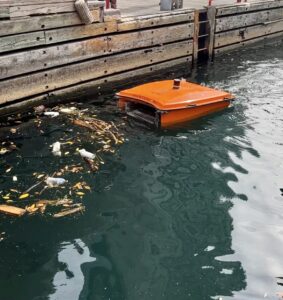
Aquadrones clean up microplastic pollution from Toronto Harbour
Canadian Plastics
Canadian Plastics Research & Development Robots & Automation SustainabilityThe results are part of PortsToronto and the University of Toronto Trash Team's 2023 Trash Trapping Program.

Over the course of only three expeditions in October 2023, the Toronto WasteSharks “Ebb” and “Flow” collected 19.2 kilograms of floating trash, including nearly 600 pieces of microplastics. Photo Credit: CNW Group/PortsToronto
When you think of drones, you probably picture them zipping through the air, where they do everything from filming real estate locations to monitoring traffic to applying pesticides. But they can operate in water too, where they’re known as either aquatic drones or aquadrones – maritime robots that collect assorted data on waterways, harbours, and seas.
And in a new all-Canadian application, they’re collecting floating microplastic – defined as plastic debris smaller than five millimetres – from Toronto Harbour.
PortsToronto and the University of Toronto (U of T) Trash Team have just wrapped up the 2023 Trash Trapping Program, which ran from May through October 2023. Consisting of eight floating Seabins and two “WasteShark” aquadrones, the project removed 43 kilograms of litter, including 62,996 pieces of small plastic pollution, from the heavily polluted harbour. This includes items such as plastic pellets, pieces of foam from food containers, plastic bottle caps, and cigarette butts (which are made of cellulose acetate, a man-made plastic material).
The two WasteSharks are remotely operated and skim the surface of the water to collect floating debris via a large catch basin. They were launched in August 2023 by PortsToronto in a pilot program that represented a Canadian first for these innovative trash traps. Over the course of only three expeditions in October 2023, the Toronto WasteSharks – nicknamed “Ebb” and “Flow” – collected 19.2 kilograms of floating trash, including large pieces of foam from construction and food containers, hard plastic parts, as well as plastic water bottles, caps, cups, lids, and straws, and nearly 600 pieces of microplastics. “With a larger capacity and remote-controlled agility, the Toronto WasteSharks are able to collect a higher volume of debris in a shorter period, collecting nearly the same amount as all the Seabins combined over the entire field season,” U of T officials said. “These can also be piloted into problem areas such as the corners of slips where we know that debris and other material can accumulate.”
PortsToronto and the U of T Trash Team have collaborated on the Trash Trapping Program in Toronto Harbour since 2019, with the goal of measuring and analyzing the debris and plastic pollution collected by trash traps in order to track trends in floating debris, determine the source of the material, and use data to identify upstream solutions. And to end on a positive note, the research team has begun to see signs of a decrease in the amount of microplastics collected in PortsToronto Seabins over the years, which could, they believe, suggest the benefits of additional outreach and education efforts toward waste reduction.
